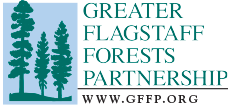GFFP is planning some new exciting projects this year that include:
Wildfire Smoke Outreach Strategy
GFFP is working with Fire Adapted Communities (FAC) Network members and local collaborators to identify issues, existing assets and needs related to assisting and communicating with communities that are exposed to smoke from managed fires and prescribed burns. This will include a literature review, content development and final production of a newspaper insert. The newspaper insert will be distributed to priority communities south of Flagstaff, AZFAC members, as well as targeted political leaders and other decision-makers. The messaging will underline the importance of why forest treatments (both thinning and controlled fire) are needed and will provide a unified message (short term impacts vs. long term benefits) from many influential organizations.
This is the first time that we are reaching out to downwind communities (south if Flagstaff) like Sedona, Verde Valley and Cottonwood. These communities receive a good amount of smoke. We hope that this will assist community members in understanding that prescribed and managed fire smoke are much more desirable than smoke from uncontrolled wildfires. In addition, managed and prescribed fires reduces the risk of severe crown replacing wildfires that produce markedly more smoke and particulates than fires that are controlled.
It is also our intention to share these products and provide tours with groups that frequently visit Flagstaff, which in the past have been comprised of national and international forestry professionals, political leaders and decision makers. The multiple methods of sharing and distributing these products will solidify FAC concepts and how they can be applied in communities that must adapt to and live with fire.
Ft. Tuthill County Park Fire Ecology Demo Site
Ft. Tuthill County Park, located just south of the City of Flagstaff, is in a strategic location to demonstrate a host of important forest management themes. Annual Park visitation exceeds 100,000 visitors, which includes residents, tourists, fire/forest management professionals, researchers, political leaders and students. Approximately 325 acres were thinned in the Park and some areas were purposely left untreated (no thinning occurred) to demonstrate what sites look like before and after treatment. We plan on designing a kiosk that will demonstrate and explain: 1) differences between untreated and treated sites; 2) the fire ecology/history of the area, 3) cost-share programs and an all-lands approach, and 4) Firewise principles. We hope to expand this in the future by developing additional messaging/trail signage (e.g., digital restoration technology use, wildfire fire smoke outreach strategy, wildlife effects) and potentially exhibiting similar messaging across the state.
Establish the AZ Fire Adapted Communities Network (AZFAC)
GFFP, along with partners like the Forest Service, Bureau of Land Management, AZ Dept. of Forestry & Fire Management, University of Arizona Agricultural Extension and the Ecological Restoration Institute are initiating a statewide Fire Adapted Community Network.
See the AZFAC page for more detalis.


